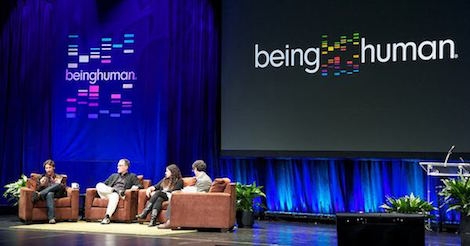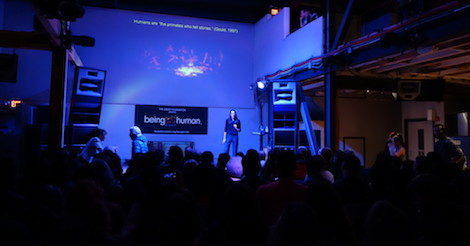Being Human
An Introduction to Evolutionary Psychology
This Being Human post is by Clark Barrett.

Imagine you’re at a friend’s dinner party when a stranger asks, “Can you pass the salt?” You grab the ceramic figure from the center of the table and hand it to her. She smiles, says “thanks,” inverts the object over her food, and shakes it.
As life events go, this is about as mundane as you can imagine. There doesn’t seem to be anything particularly special in your ability to respond to an ordinary request in English, to hand someone a salt shaker, or to engage in a pleasant dinner conversation with a group of people you’ve never met. And yet, as it turns out, these abilities are special: they are the products of evolution.
At first glance, this claim might seem surprising. On the one hand, it is generally recognized that human brains must be the products of evolution. Indeed, every kind of analysis available to science, from anatomical comparisons to brain scans to gene sequencing, confirms that our brains bear evolutionary relationships to the brains of our animal relatives, just as our bodies do.
Yet even people who accept these facts have a strong urge to look for some additional explanation. Surely it can’t all be evolution. You wouldn’t want to posit that evolution has provided you with an innate knowledge of salt shakers, the English language, or mealtime etiquette. Such skills clearly cannot be part of human nature, but must come from learning, the environment, culture: from “nurture.”
The nature / nurture distinction is a time-honored solution to the problem of explaining how we have minds that are evolved yet flexible. Indeed, it is still popular in some areas of academic psychology to think about the mind as composed of two layers, like a cake: on the bottom, an evolved, “innate” layer corresponding to our animal instincts (for example, mechanisms of perception and emotion) and on the top, like icing, a more flexible, perhaps human-specific layer (what we call thinking, decision-making, consciousness, and the self).
However, recent research on how evolution has shaped the mind and its development suggests that this view does not do justice to biological reality: evolved, innate, inflexible, and unconscious are not synonyms. For example, innate implies structures that develop the same way in everyone, regardless of experience and without any interaction with the environment. Yet abundant evidence suggests that evolution has shaped brains to use information from experience and the environment at every level, including conscious thought. Indeed, if the function of our brains is to guide our decision-making in the world, how could the evolved bits be designed to ignore it?
These considerations might lead you to think that brains are just giant plasticity machines: huge bundles of neurons whose main design feature is their flexibility itself. But this view would miss the evidence all around us, in psychological data and everyday life, that the brain doesn’t just passively take in information but is designed to process it in complex and functionally elegant ways. Even the most mundane of daily activities, such as your encounter at the dinner party, involve the interaction of multiple evolved mechanisms, each of which uses information from experience and the immediate surroundings to carry out its function.
Take, for example, the simple fact that you’re at a dinner party: something that even our closest evolutionary relatives, chimps, don’t have. Groups of chimps do get together to eat food, but not in ways that vary in terms of social norms and traditions, including etiquette, as human dinner parties do. And chimps don’t sit down to eat peacefully, and even share their food, with strangers.
Both these abilities—our capacity to acquire cultural norms and to interact peacefully with strangers—require special, evolved mechanisms that not all species have. Chimps are indifferent to the cooperative requests of strangers, even when it would cost nothing to satisfy those requests. For example, given the option to pull a rope that gives me a banana versus a rope that gives both me and you a banana, chimps show no preference, whereas humans can take the cost-free opportunity to deliver a benefit to someone else.
This kind of cooperativeness appears to be rare in other animals because there is no benefit to such helping. Humans, on the other hand, have evolved a variety of mechanisms, such as the ability to track others’ reputations and the motivation to develop a positive personal reputation, that can make it worthwhile to help others by doing things such as passing the salt. Indeed, recent research suggests that being nice might be a kind of psychological default in humans: when given little time to decide, people often do the nice thing, acting more selfishly only when given time to weigh the costs and benefits. Chimps have no such default.
A second mechanism at play at the dinner party is what is sometimes known as “theory of mind:” the ability to make inferences about what others want, know, and intend. As any sufficiently sassy five-year-old will tell you, a technically acceptable response to the question “Can you pass the salt?” is to say “yes” and then do nothing. However, instead of interpreting the question as an inquiry about your physical ability to pass the shaker, you interpreted it, correctly, in terms of the guest’s underlying intentions: to request the salt in a polite, culturally conventionalized manner.
The difficult thing about inferring others’ mental states, such as their intentions and desires, is that they are invisible. While humans aren’t the only animals that can infer others’ mental states, we can infer a larger variety than can any other animal and in a wider array of contexts. For example, a dog can infer from her owner’s pointing that he is intending to show her where hidden food is located, and a subordinate chimp can infer from a dominant’s eye gaze which piece of food the dominant intends to take (abilities that require, in each case, evolved mechanisms that non-social species don’t have).
Humans can do this, and more. For example, beginning in the first year of life, human babies begin to track what others believe about the world separately from what they themselves believe. Although we’re sometimes not aware of it, this ability has an important function in conversation because nearly everything we say or ask makes implicit assumptions about what the person we’re talking to knows or doesn’t know (for example, that “can you X”? is a conventionalized form of request in English).
Finally, there is your interaction with the salt shaker. This, too, relies on evolved mechanisms. In addition to the host of evolved perceptual mechanisms required to see and reach for the shaker, there is your treatment of the object—in this case, a ceramic figure—as a member of a culturally conventionalized artifact category, salt shaker.
A growing body of research on artifact cognition suggests that the human capacity to treat artifacts as having standardized functions has elements that are both unique to humans, and that have both upsides and downsides. For example, starting in the first year of life, human infants learn from a single demonstration what an artifact is “for,” and generalize this to other members of the artifact category (from one salt shaker to another). When we see such a demonstration, we assume that every action the demonstrator does on purpose (relying, again, on mental state inference) is part of how you are “supposed” to use the object—even when the reason for the action isn’t clear. Chimps, interestingly, don’t do this; they fiddle with the object, and adopt actions that appear useful.
Similarly, humans exhibit what is known as “functional fixedness:” once we know the function of some object, such as a salt shaker, we are impaired at imagining possible alternative uses for the object. The benefit of these types of rigidity appears to be that once we have identified an object as a member of a known artifact category, such as salt shaker, we immediately know what to do with it—invert it over our food and shake—without entertaining other options.
For each of these bits of everyday thought and behavior, you might ask, “How do you know that evolution has anything to do with it?” Indeed, this is the question that evolutionary psychologists ask ourselves every day in our research. As in most scientific research, the answers do not come in the form of a single moment of proof. Instead, they are arrived at by carefully thinking through the different possible explanations for a given phenomenon, and then searching for evidence that weighs for or against these hypotheses. These pieces of evidence can come from varied sources: experimental psychology studies in the lab, studies with babies, comparative studies across cultures, studies across different species, data from brain mapping, genetics, and more.
For example, in the case of theory of mind (the ability to infer others’ mental states), developmental studies show that components of the ability, such as belief tracking, develop at specific times in infancy. Cross-cultural studies show that these developmental trajectories follow a similar path across human cultures. Comparative studies with primates, carnivores (dogs and wolves), and birds show that some components of theory of mind are present in other species, while others are not—and that the particular abilities of a species are closely tied to its ecology.
For example, corvids, a family of clever birds that includes crows, ravens, and jays, keep track of who has seen them hiding food and move the food to avoid having it pilfered. Dogs are sensitive to communicative pointing by humans, while chimps are less so—thought to be because dogs have been bred to cooperate with humans (and evolved from a cooperative species, wolves) whereas chimps, as mentioned above, do not communicate cooperatively in the wild. Humans, like dogs, have an evolutionary history of cooperative communication, perhaps explaining why we differ from chimpanzees in this ability to infer others’ communicative intentions.
Even in well-studied cases such as theory of mind, of course, there remain open questions. For example, brain mapping studies in which people are asked to make inferences about others’ beliefs while in a scanner have begun to home in on brain areas that are particularly active in such tasks, including an area called the temporo-parietal junction (TPJ). However, the TPJ is also active during other, non-mentalistic tasks. Thus, researchers still continue to test hypotheses about the exact function of the TPJ, to determine whether it has been modified in humans to support our apparently unique theory-of-mind abilities. However, it is exactly through the development and testing of such hypotheses that we make progress in understanding the brain’s mechanisms.
The human brain is one of the most complex objects known to science. The evolutionary pathways that have given rise to its various structures and processes—as well as the developmental machinery that builds these structures anew in each of us—must be complex as well. Reverse engineering these pathways through the process of developing and testing hypotheses about them is a challenging enterprise, and one that is nowhere near complete. But the excitement of evolutionary psychology lies in cases like the evolution of cooperation, theory of mind, and tool use, where the work of many scientists across disciplines is beginning to shed light on the underlying mechanisms and how they evolved. This kind of research, drawing on converging lines of evidence from many disciplines, is beginning to deliver answers to the tough questions about how and why human minds work as they do—even in as seemingly mundane a context as passing the salt.
Clark Barrett is an Associate Professor of Anthropology and a member of the Center for Behavior, Evolution, and Culture at the University of California, Los Angeles.


